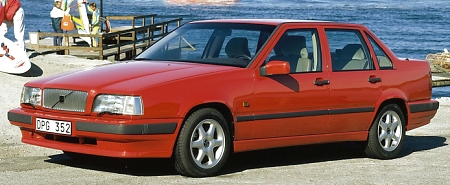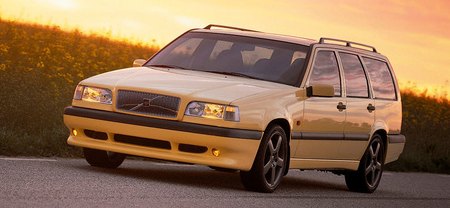 Volvo had always been renowned for safe, roomy and durable, but when it came to driver appeal, it ranked last among European prestige brands. This perception was suddenly changed in 1991 with the launch of 850. The 850 surprised many motoring journalists and enthusiasts with strong performance and handling. It excelled against not only other Volvos but also some rivals bearing a propeller badge or 4 rings at their noses. This was the first Volvo with true driver appeal. The 850 took as long as 13 years to develop from concept to production. This was necessary because it was a clean-sheet design that shared nothing with 240 (its direct predecessor) or 740/760. It switched to a new front-wheel-drive and transverse engine layout, a brand-new 5-cylinder multi-valve engine, a pair of compact gearboxes (5-speed manual or 4-speed auto) and a unique semi-independent rear suspension called Delta-link. The latter wasn't renowned for ride comfort, but it enabled a small degree of passive rear wheel steering and gave the car excellent handling. In the safety side, 850 introduced a side impact protection crash structure called SIPS, seat belt pretensioners and an integral child seat, so it kept leading the world in passive safety. Its boxy body kept the traditional style of Volvo yet appearing more modern, thanks to flush windows and slightly curved panels. It also brought a modern drag coefficient of 0.32, improving high speed performance a lot. Moreover, the boxy greenhouse offered more interior room than any rivals of comparable sizes. Better ergonomics and outward visibility, too. In short, the 850 was so right from the outset!  850 T-5R Estate The all-alloy 5-cylinder engine was developed with the help
of Porsche. It was part of a modular family which also gave birth to
the 3-liter straight-six of 960. It was available in either 2.0-liter
or 2.4-liter displacement, equipped with DOHC 10-valve or 20-valve
heads. The 2.4-liter 20V engine produced a respectable 170 hp in a
free-revving manner, accompanied with an enthusiastic sound that only a
5-pot can produce.
Even better was the turbocharged T-5, or known as 850 Turbo in some markets. Its 2319 c.c. engine was assisted by a Mitsubishi turbocharger to produce 225 horsepower, a very high figure for its size at the time. This gave it very strong performance – a top speed of about 145 mph and 0-60 mph sprint just shy of 7 seconds. Beefed up suspensions and brakes brought a handling better than any non-M-badge BMWs. It was praised for superb body control and balance, impressive grip and quick steering. Inevitably, the powerful front-wheel-drive machine displayed some torque steer and it would spin the front wheels if pushed in slow corner. Still, it was a keen driver's car that begged people to drive hard. The faster it ran the better its damping felt and the keener its chassis responded. The same character could be found on the following T-5R. Basically, it was a T-5 with all the optional equipment installed – not just sportier wheels, tires and spoilers but also all the safety and luxury equipment. Offsetting the extra weight was a revised ECU, which allowed 30 seconds of overboost to 240 hp. The T-5R was produced as a limited edition to celebrate the 850's participation in British Touring Car Championship, in which the TWR-run 850 Estate surprised spectators with strong results. Like the race car, the road-going T-5 and T-5R changed very much our perception on Volvo.  850R The T-5R was a big success. Originally Volvo planned to build 2500 cars in both saloon and wagon form, but since demand outstripped supply it eventually raised the total to 5500 cars. Thanks to the success, Volvo became confident to offer the performance model on permanent basis, albeit in a different name, 850R. The new car got a modified engine (including larger turbo and intercooler) to produce an extra 10 horsepower and 37 pound-foot of torque. Besides, it added a Torsen LSD and viscous coupling to the front axle to tame the wild power. This should be the fastest 850 of all. Since 1996, the whole 850 line was renamed to S70 and V70. It continued to live for 4 more years, then it was partially replaced by the S80-based V70 estate. Until today, Volvo has yet to build another car with so strong driver appeal. |